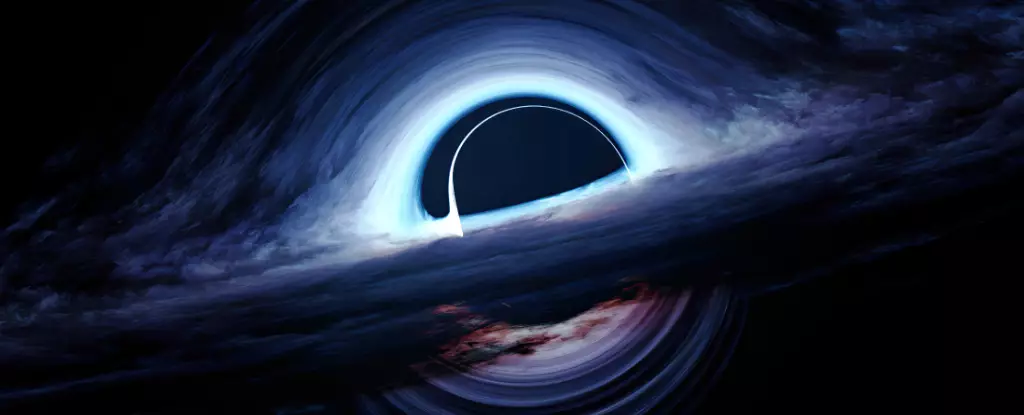Supermassive black holes stand as some of the most formidable phenomena in the universe, with masses weighing in at around a billion times that of the Sun. These colossal entities are not merely relics of cosmic history; they are dynamic centers of power and mystery found in the hearts of galaxies, often manifested as quasars—extremely luminous and compact sources emitting significant energy. The existence of these black holes during the universe’s infancy, notably within just a billion years after the Big Bang, raises profound questions about their origins and the processes that facilitated their growth.
The growth of black holes predominantly occurs through a process known as accretion, where surrounding matter spirals into the black hole, creating immense radiation. However, this feeding process is not continuous; rather, black holes “eat” in intervals, leading to fluctuations in brightness. This creates a dilemma for astronomers: as they study the early universe and the existence of massive quasars, they are faced with the challenge of reconciling the rapid growth of these entities with the finite timeline available since the Big Bang.
In order to sustain the development of supermassive black holes, several formation theories have emerged. One conventional explanation posits the existence of primordial black holes, theorized to have originated shortly after the Big Bang. Yet, while this concept works for black holes of lesser masses, it struggles to account for the abundance of massive black holes observable in the early universe, according to standard cosmological models.
Another established pathway to black hole formation involves the death of massive stars. When such stars exhaust their nuclear fuel, they can collapse under their gravity, resulting in the formation of stellar black holes. If these black holes arise in dense stellar neighborhoods, they have the potential to merge and accumulate mass rapidly.
A compelling alternative, however, focuses on what are termed “heavy seeds.” Among these, the direct collapse model is particularly intriguing. In this scenario, when gas clouds within dark matter structures fail to ignite stars due to surrounding radiation, they collapse directly into black holes. However, this model suggests that only a limited number of dark matter halos have sufficient mass to yield such significant seed formations.
Recent advancements in astronomical techniques have yielded surprising discoveries about black hole populations in the early universe. The difficulty in identifying black holes within their nascent galaxies has historically hindered our understanding of their prevalence. Observations of luminous quasars confirmed their presence, but statistical estimates of black holes remained elusive. Over a 15-year observational period, researchers sought variations in brightness among early galaxies. This extensive study revealed an astonishing conclusion: far more black holes reside in these primitive galaxies than previously anticipated.
The cutting-edge capabilities of the James Webb Space Telescope (JWST) have been instrumental in expanding our comprehension of early black holes. This observatory has begun uncovering details about faint quasars, bolstering the notion that black holes outnumber the models of direct collapse, thus requiring researchers to reconsider their assumptions about black hole formation.
Amid these developments, an intriguing proposition emerges: what if considerable quantities of dark matter particles are incorporated during the process of star formation? As gas clouds collapse to form stars, capturing dark matter particles may alter the internal dynamics, preventing the onset of nuclear ignition. This scenario could lead to an extended lifespan for these stars before they ultimately collapse into massive black holes.
Such theories have vital implications for our understanding of black hole formation in the infant universe. They suggest that a variety of complex and interlinked processes were at play, allowing for a greater population of black holes than we may have presumed.
The field of black hole research is rapidly evolving, particularly with future astronomical missions such as Euclid and the Nancy Grace Roman Space Telescope, which promise to enhance our census of early quasars. The NewAthena mission and the Square Kilometer Array will delve deeper into the intricate processes surrounding these enigmatic entities.
As we turn our gaze toward the capabilities of JWST, astronomers are optimistic that a more precise understanding of black hole numbers and their formation during the earliest epochs of the universe is within reach. The potential to witness black hole formation events and the energetic explosions associated with the collapse of primordial stars could revolutionize our understanding of the universe’s evolution.
While the genesis of supermassive black holes remains one of the most exhilarating mysteries in modern astrophysics, ongoing research and technological advancements will inevitably continue to illuminate these cosmic giants and the intricate processes that brought them into existence.


Leave a Reply